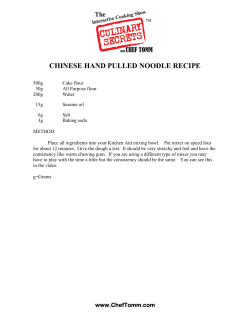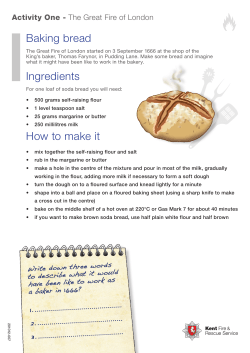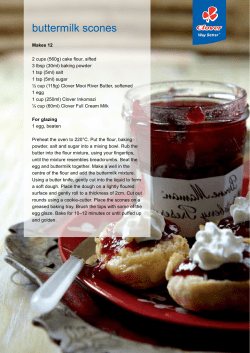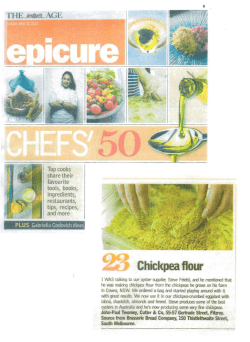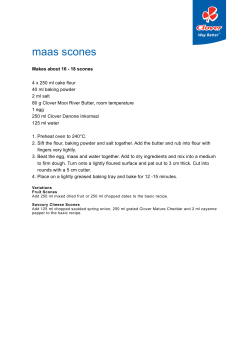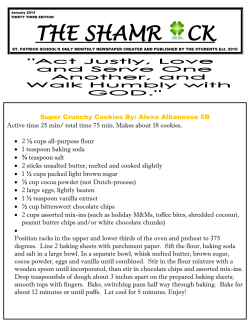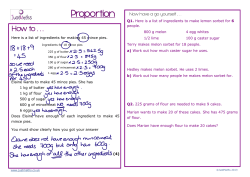
Baker’s Percentages and Formula Weights Baker’s percentages
Baking Math Learning Centre Baker’s Percentages and Formula Weights Baker’s percentages give the weight of each ingredient as a percentage of the total weight of flour used. Let’s review percentages briefly before moving on to baker’s percentages. Recall that a percentage like 75% can also be expressed as a fraction (75/100) and as a decimal (0.75). Whenever we use a percentage in an equation or to calculate a weight, we always convert from the percent form to the decimal form first. You can do this by taking the % and dividing by 100, or you can move the decimal two places to the left. See below for an example. Example 1: Convert 90% to a decimal. Answer: Method 1 → 90% = 0.90 Method 2 → 90% = 90.0 (now move the decimal two places left) = 9 0. 0 = 0.90 To convert from a decimal to a percentage, we multiply by 100, which is the same as moving the decimal two places to the right. As mentioned above, baker’s percentages express each ingredient’s weight as a percent of the weight of flour used. In other words, the weight of an ingredient divided by the weight of flour and then multiplied by 100 will give the baker’s percentage of that ingredient. The equation below shows this relationship: 100 Equation 1: % Example 2: Find the baker’s percentage of sugar when the total weight of flour in the formula is 3 lb and the weight of sugar is 1.5 lb. Answer: . 100 50% Remember: in order to compare the weight of an ingredient to the weight of flour, both weights MUST BE IN THE SAME UNIT! If either weight is a mixed unit (e.g. 1 lb 4 oz), it must be converted to a single unit before the calculation can be done! Usually ounces are the best weight to work in for the U.S. system, and grams for the metric system. © 2013 Vancouver Community College Learning Centre. Student review only. May not be reproduced for classes. Authored by by Emily EmilySimpson Simpson Example 3: Find the percentage of salt when the total weight of flour is 2 lb 8 oz and the weight of salt is 0.2 lb. Answer: First we need to convert to the same unit: 2 lb 8 oz flour → 40 oz flour Since flour is in ounces, we also want the weight of salt in ounces: 0.2 lb → 3.2 oz salt Now we can plug into our equation to get the baker’s percentage of salt: . 100 8% **Note that if there is more than one type of flour in the recipe, the sum of the flour weights will represent the 100% weight to which every other ingredient is compared.** FORMULA WEIGHTS (1) Calculating an Ingredient Weight When the Weight of Flour is Known In this case, you would have an ingredient list where the weight of flour is given and flour is the 100% ingredient. Other ingredients are given as baker’s percentages. You can use these percentages to find how much of the other ingredients are needed by using the following equation: Equation 2: Example 4: Below are some of the ingredients for a chocolate cake. The weight of flour is given, and the proportions of other ingredients as baker’s percentages are shown. Calculate the weights needed for shortening and milk. Cake flour Baking powder Shortening Cocoa Milk 3 lb (100%) 4% 50% 7% 75% Answer: We read this list as saying shortening is 50% of flour weight and milk is 75% of flour weight. Plugging into our equation for shortening, we get: 3 1.5 Note that we divide 50% by 100 first to convert the percentage into a decimal since we are using it in a calculation. © 2013 Vancouver Community College Learning Centre. Student review only. May not be reproduced for classes. 2 Now to find out how much milk we need, we repeat our steps. 75% → 0.75 , and we know the weight of flour, so plugging into our equation we get: 0.75 × 3 lb = 2.25 lb milk Remember you can always do a common sense check – if an ingredient is <100%, its weight should always be LESS than the 100% ingredient weight. This is true in the example above (flour was 3 lb, shortening was 1.5 lb). If an ingredient is >100%, its weight should always be MORE than the 100% ingredient weight. If the 100% weight is given in more than one unit (for example 1 lb 12 oz), always convert to a SINGLE unit (for example, lb or oz) BEFORE determining the weight of an ingredient based on its percentage. (See worksheet on Conversions for review). Example 5: If a formula contains 7% cocoa and flour is 2 lb 4 oz (100% weight), determine the amount of cocoa needed. Answer: We need to convert the flour weight to a single unit first: 2 lb 4 oz → 36 oz flour. Now we repeat the process in the above examples. Cocoa weight = 0.07 × 36 oz = 2.52 oz We take this answer and round up to the next highest number to make it easier to work with. 2.52 oz ≈ 3 oz cocoa. (2) Calculating an Ingredient Weight When the Weight of Flour is Not Known In this case, you are told that flour is the base weight (100%) but the amount of flour is not given. However, you do have the percentage and weight of another ingredient (ex., baking powder is 14 oz, 5%). Now you are asked to determine the amount of flour (or another ingredient in the recipe). How do we do this? We use the equation below: Equation 3: We take the total weight of the ingredient that is given and divide it by the ingredient’s percentage (which is converted to decimal form first). Let’s think about this for a very simple example. If I had 4 pounds of butter, and butter was 50% (or half) of the flour weight, the flour weight would be 4/0.5 = 8 lb flour. This probably seems logical and you could have determined the flour weight without using the above equation, but it does come in handy for more complicated percentages and weights. © 2013 Vancouver Community College Learning Centre. Student review only. May not be reproduced for classes. 3 Example 6: Given the following information, determine the amount of flour needed. Cake flour Egg whites 100% 3 lb (60%) Answer: We want to know the total weight of flour. So we take Equation 3 (remembering to convert our percentage of egg whites to the decimal form first) and get: 3 0.60 5 Example 7: Given the following information, determine the amount of flour and butter needed. Bread flour Butter Total dough weight 100% 50% 9438 g (377.5%) Answer: We need to find the weight of flour first. Even though the bakers percentage of dough weight is greater than 100%, we still convert to a decimal the same way: 377.5/100 = 3.775. Now plug into the formula: 9438 2500 3.775 Now that we know the flour weight, we can find the butter weight using Equation 2: 2500 1250 Practice Exercises 1. Finding the percentage of an ingredient. Determine the percentage of each ingredient in the following formula. Convert all weights to a single unit of measurement first. Ingredient Weight Milk Yeast Poppy seeds Eggs Bread flour Sugar Salt Butter, softened 8 oz 2 oz 1.6 oz 1 lb 4 oz 2 lb 2 oz 0.8 oz 1 lb 12 oz Converted Weight (oz) © 2013 Vancouver Community College Learning Centre. Student review only. May not be reproduced for classes. Percentage 100% 4 2. Determining the weight of an ingredient when the flour weight is known. Fill in the following table and determine the weight of each of the ingredients. Ingredient Butter Sugar Salt Eggs Water Vanilla extract Pastry flour Cocoa powder Baking powder Baking soda Chocolate chips Weight (Metric) 900 g Percentage 40% 53.3% 1% 33.3% 20% 1.7% 100% 15% 2.5% 0.83% 20% Weight (U.S.) 1 lb 14 oz 3. Determining the weight of flour (and other ingredients). Use the following information to fill in the rest of the table. Remember to determine the flour weight FIRST and then the other ingredients. Ingredient Shortening Sugar Salt Baking soda Eggs Almond extract Pastry flour Currants Total dough Weight (Metric) 1676 g Percentage 82% 113% 1.6% 1.6% 37% 2% 100% 35% 335.2% Weight (U.S.) 5.5 oz Answers 1. Ingredient Weight Milk Yeast Poppy seeds Eggs Bread flour Sugar Salt Butter, softened 8 oz 2 oz 1.6 oz 1 lb 4 oz 2 lb 2 oz 0.8 oz 1 lb 12 oz Converted Weight (oz) 8 oz 2 oz 1.6 oz 20 oz 32 oz 2 oz 0.8 oz 28 oz © 2013 Vancouver Community College Learning Centre. Student review only. May not be reproduced for classes. Percentage 25% 6.3% 5% 62.5% 100% 6.3% 2.5% 87.5% 5 2. Ingredient Butter Sugar Salt Eggs Water Vanilla extract Pastry flour Weight (Metric) 360 g 478 g 9g 300 g 180 g 15 g 900 g Percentage 40% 53.3% 1% 33.3% 20% 1.7% 100% Cocoa powder Baking powder Baking soda Chocolate chips 135 g 22.5 g 7.5 g 180 g 15% 2.5% 0.83% 20% Weight (U.S.) 12 oz 16 oz (1 lb) 0.3 oz 10 oz 6 oz 0.5 oz 1 lb 14 oz (30 oz) 4.5 oz 0.8 oz 0.3 oz 6 oz Ingredient Shortening Sugar Salt Baking soda Eggs Almond extract Pastry flour Currants Total dough Weight (Metric) 410 g 565 g 8g 8g 185 g 10 g 500 g 175 g 1676 g Percentage 82% 113% 1.6% 1.6% 37% 2% 100% 35% 335.2% Weight (U.S.) 1.3 oz 1.9 oz 0.03 oz 0.03 oz 0.6 oz 0.03 oz 1.6 oz 0.6 oz 5.5 oz 3. © 2013 Vancouver Community College Learning Centre. Student review only. May not be reproduced for classes. 6
© Copyright 2025
